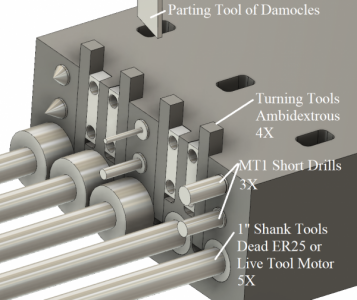- Joined
- May 14, 2015
- Messages
- 179
I notice that nearly all linear guide blocks have threaded holes (including mine), but there are a few with bored through holes. Since my toolplate is about 3.5" thick, it seems like threading into it vs. drilling through is a lot more convenient. Thoughts? I'd rather not bore out the ones I have unless the pros outweigh the cons.
I also rejiggered how I am doing my turning-tool clamps (they are in pairs between tools, vs. staggered) and now have room for MT1 drill sockets (for short tools) if I really want them --only trick would be figuring out how to tap them back out from the rear of the taper, when it's a solid block of toolplate back there. So that's a total of 20 tool positions at this point. When the stock is only 1" max diameter it can fit between a lot of obstacles.
Another necessary change that may have a fortuitous, if unusual consequence was hanging the toolplate out 1.5" past the X-axis guide blocks nearest the spindle. This was done so I'd have access to the underside/backside of the tool plate where the ER25 collet holders plug in, so they could be secured with a pair of set screws (not super convenient, but better than all my other ideas). It's less than a 1:2 cantilever ratio so I'm not super worried about loss of rigidity, but it does mean the Z-axis guide rails can set back 1.5" from the spindle accordingly...leaving a very narrow gap-bed, that could accommodate a large diameter 5C face plate ('large' meaning <10"). Obviously I wouldn't spin the poor thing at 4000rpm, but it opens the door for respectable-sized sheet engraving using Y/C polar coordinates, and at the least improves user access at the tool change area. Maybe I could produce my own vinyl press-masters, lol.

I also rejiggered how I am doing my turning-tool clamps (they are in pairs between tools, vs. staggered) and now have room for MT1 drill sockets (for short tools) if I really want them --only trick would be figuring out how to tap them back out from the rear of the taper, when it's a solid block of toolplate back there. So that's a total of 20 tool positions at this point. When the stock is only 1" max diameter it can fit between a lot of obstacles.
Another necessary change that may have a fortuitous, if unusual consequence was hanging the toolplate out 1.5" past the X-axis guide blocks nearest the spindle. This was done so I'd have access to the underside/backside of the tool plate where the ER25 collet holders plug in, so they could be secured with a pair of set screws (not super convenient, but better than all my other ideas). It's less than a 1:2 cantilever ratio so I'm not super worried about loss of rigidity, but it does mean the Z-axis guide rails can set back 1.5" from the spindle accordingly...leaving a very narrow gap-bed, that could accommodate a large diameter 5C face plate ('large' meaning <10"). Obviously I wouldn't spin the poor thing at 4000rpm, but it opens the door for respectable-sized sheet engraving using Y/C polar coordinates, and at the least improves user access at the tool change area. Maybe I could produce my own vinyl press-masters, lol.




